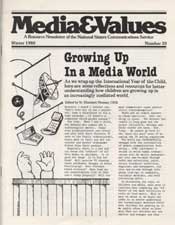Growing Up in a Media World
|
This article originally appeared in Issue# 10
|
As we wrap up the International Year of the Child, here are some reflections and resources for better understanding how children are growing up in an increasingly mediated world.
Recently I heard a teacher say, "Don't ever try to run a projector, tune a television or fix a tape recorder... if there's a competent third-grader around."
How true. When I was a child, the Brownie box camera was a technological marvel. Today even kindergartners can record and play back their favorite TV show on the family video recorder, learn math on their own $10 calculator and master videogames faster than their parents.
Regularly there is a hew and cry about the "effects" of all this media on children. Is it good for them? Is it bad for them? Will passive TV viewing cause permanent changes in brain functioning? Does violence breed violence? Does loud music over stimulate kids so they can't sleep properly? Will too many commercials cause narcissistic over consumption?
There are no simple answers to these questions. Only one thing is clear. The Brownie box camera is long-gone and the pocket calculator, Betamax and Dolby stereo are here. Now. Today. We cannot go back to the "good old days" even if we unplug the TV during suppertime.
The world has fundamentally changed with the introduction of modern communications technology. 1980 introduces a decade in which human communication will be mostly mediated — not only one-to-many through radio and television, cable, direct broadcast satellites, magazines and newspapers, but also one-to-one through telephone link-ups to computers, facsimile machines, and word processing units.
In discussing the topic of children and media, much more is involved than lamenting the "effects" of too much television or radio or loud music. What we must be about as we begin the 1980s is to better understand the increasingly mediated world that children are growing up in. We adults often think we know more than our children who are smaller and younger and thus "less experienced." But an 11-year old once wrote:
It is impossible for anyone to enter our small world. The adults don't understand us. They think we're childish. No one can get in our world; It has a wall twenty feet high, and adults have only ten feet ladders.- Ross Falconer, age 11*
Hammer anyone? It's time we built taller ladders.
One woman who has already begun is Pat Edwards, executive director of the Primary English Teaching Association in Australia. In a recent Project Focus Viewsletter, she writes especially to teachers who put down their students' TV viewing and then complain about the difficulty of communicating with the young. But they refuse to enter the child's world or share their out-of-school experience. "The average primary school pupil spends 15 hours a week in front of TV. That's the equivalent of three school days. During much of recess and lunch children discuss what they saw the night before. They have never known life without TV.

"A class has a way of 'exploding' if a teacher brings last night's viewing into the conversation. Words start to tumble out. Everyone -- even the slowest thinker -- wants to contribute; ideas are tossed around. It's an enthusiasm I want to tap because it's alive, it's vital, it's NOW, as the kids would say.
"...TV is an enormously powerful educational force. We have no choice but to use it. Our ways of communicating, our access to knowledge, our whole lives are being fundamentally altered by it... TV can serve as a wonderful beginning to all kinds of projects. It can stimulate much more exact and lively teaching. But above all its strength is in its immediacy and drama. It is the great communicator and we teachers can't afford to let it go on communicating unchallenged. Sure, some programs are drivel, but some are surprisingly good. So help children to discriminate, to be critical. Help them to demand what we know they need. Show them the mind expansion that comes from the best programs. But our starting point must be an interest in the TV that they are watching."
Kelvin B. Canavan, FMS Life in the Media Age
What media do children themselves identify with?
When asked to give a one-word description of children and media today, Dr. Jim Danowski, researcher at the Annenberg School for Communication in Los Angeles, said "computer freaks ." Asked to explain, he said that he had been trying to find out how children perceive the inter-relatedness of different media in relation to themselves.

First he had a class of junior high students make a list of all the possible media they knew about-TV, radio, tape recorders, records, telephone, magazines, newspapers, computers, etc. Even satellites were included. Then, on a piece of paper, he asked them to "place" each medium in relation to a center dot, which represented themselves.
What came closest? The telephone, records, and…computers! At first surprised, Dr. Danowski then recalled that in a recent visit to a science museum, the computer display was mobbed by kids -- who promptly learned to put the terminal on "local" and began creating their own interesting spatial designs on the video screen.
Where was television? "It's part of the woodwork of kids' lives today -- it's there, but not right next to the self." In fact, the students said they often watched television so they had something to talk about with adults!
But when kids do watch TV, after school and week-end mornings, they'll soon see some new 30-second spots illustrating nonviolent and positive solutions to conflict situations. Developed by the United Methodist Church, the Disciples of Christ and the Church of the Brethren, the "Children's Growing Spots" are available locally and on the network. "The Rabbit" goes like this:
Two children:
"I'm gonna take care of the rabbit."
"I wanna do it."
"We can't both do it. go!"Narrator:
"What would you do?"Child:
"I know. You feed, I'll water."Narrator:
"When two people want to do the same thing, one idea is to divide the job and each do part of it."Children:
"Tomorrow you feed and I'll water." "Deal."Narrator:
"And that's a good way to share."
From Brazil comes a report about what kids say about themselves -and the environments adults create for them -- through their own films. Marialva Monteiro of CINEDUC Educational Cinema, who has helped children of all ages produce over 70 films in the last few years, offers these comments on student filmmaking.
- The pedagogical method and discipline adopted by a school are markedly responsible for the amount of creativity in the child who makes films. In schools where strict discipline is enforced, children produce simple films lacking interest. In schools where there is greater freedom, the subjects chosen are more solid.
-
 In schools which use competition as a motive for learning, children will often write film-scripts dealing with money-seeking, theft, bank '-robberies and reward-in-kind of actions.
In schools which use competition as a motive for learning, children will often write film-scripts dealing with money-seeking, theft, bank '-robberies and reward-in-kind of actions.
- The influence of TV supermen which stimulates the desire for super-power is evident in stories composed by youngsters up to 10 years old. Their principal characters are usually Dracula, Batman and Tarzan.
- Films where the heroines are housewives, mothers, princesses or fairies occur more frequently in girls' schools which emphasize a simplistic attitude toward life and lack of knowledge of the world.
- During the last few years, films about sports reflect children's growing exposure to sports events through the mass media.
- The beginnings at adolescence of a preoccupation with reality is confirmed by the increase in the number of documentaries by early adolescents.
- Finally, a strong desire to appear in their own films is evident in young children, especially.
From OCIC Newsletter.
*From Once Around the Sun, ed. by Brian Thompson (Oxford University Press).


